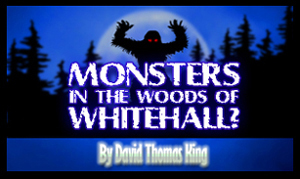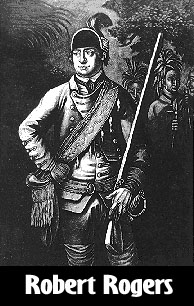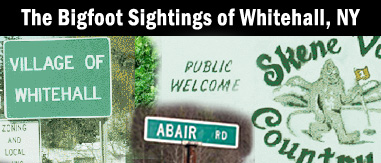|

PART ONE
NESRA – Friday April 15th, 2005 –
The wilderness of the Southern Adirondacks.
It was a cold, but clear night. At 37°F, it was not your typical camping weather.
Chuck and I stood near the campfire at our makeshift base-camp as the pork chops
hissed and sizzled on a store-bought rack. We exchanged light conversation as
Chuck tended the fire and I leaned on a wooden horse hitch, made from what
appeared to be cut-up telephone poles. By all the signs, we were the very first
campers to use that site since Fall of 2004. Little did we know that as the
clock neared 10:30PM, the pace of things was about to pick up quickly.
“I think I just heard a wood knock from the West,” Chuck said suddenly
with a calm but serious tone in his voice.
His statement brought all my senses to immediate attention. I looked at my
watch. It was 10:29.
Within ten seconds of the first knock, there came two more, only much closer,
and this time, much louder.
Thwack! Thwack!
Being from the Whitehall area, Chuck had heard this unusual wood-knocking
phenomenon before but this was new to me.
I took it as my cue to grab my “knocking” board and position myself to return
the gesture. Earlier that afternoon we had taken several “practice” swings with
a board against a tree to determine what sounded right, but we had done no other
“knocking” of our own that afternoon or evening. This wood knocking incident
appeared to be completely unprovoked.
Things That Go “Thump” in the Night
As I was just about to make my first
return knock, both Chuck and I began to hear strange “bipedal” sounding “thumps”
approaching our camp from the West. In concert with the first thump, a barred
owl began hooting loudly in the distance as if it were alarmed. I immediately
put the board down.
Chuck and I became motionless and silent, pointing simultaneously in the
direction of sounds that were now becoming louder and more intense as they
approached.
Thump! Thump! Thump! Thump!
At their closest point we could not only hear these unusual thumps but we could
slightly feel them as well. We also both noticed that these noises were not
quadrupedal in nature. There was no “flam” or “gallop” to these sounds such as a
heavy moose or a bear would make. These were single and very distinct “thuds”
that crescendoed with slight but discernable vibrations in our ankles as they
followed the smoke trail toward our camp. Just on the other side of a forested
knoll the strange sounds paused for few short seconds, and then began to decrescendo
off into the distance, heading Northward, away from our camp. There were more
than thirty of these thumps in all, spaced a little less than a second apart.
Chuck and I looked at each other as if to say, “What the heck was that?”
This was supposed to be a dry run – an experimental expedition that was meant to
prepare for Kevin, Mike and Brian, who would be joining us the following night.
We really weren’t expecting to encounter anything at all that first evening.
After a brief discussion, I took a flashlight and investigated the hill. Other
than some disturbed leaves and some indiscernible indentations, I could find
nothing that yielded any clues as to what had made the unexplained noises. The
following morning, I tried to reproduce the noises as Chuck listened from the
camp but I failed at every attempt. Even the heaviest boulder I could drop did
not come close to reproducing what both Chuck and I heard and felt that
unforgettable evening.
Was this an actual run-in with the legendary Sasquatch, or was there some other
explanation for our encounter? Hours of speculation lead to no definite
conclusions. Chuck is a seasoned hunter and I’m no stranger to the woods myself,
but neither of us had ever experienced anything even remotely like this before.
The Evidence Mounts
This was our first official NESRA
expedition into the Adirondack wilderness and we had set up camp only five or
six miles away from the famed town of Whitehall, New York. We didn’t pick our
first expedition site randomly; we selected the Whitehall region knowing it has
a rich history of face-to-face Bigfoot encounters. In fact, earlier that
afternoon we had met with a very credible witness who reportedly had a hair-raising,
face-to-face encounter in 1997 with a seven-foot-tall, hairy, manlike creature,
less than a mile from where we had parked our vehicles. Apparently, he had
fallen asleep in his car and was awakened by scratching noises on the metal roof
at two in the morning. He tried to open his car door but it bounced off of
something! He pushed it again and the obstruction seemed to be gone, but as he
stepped out of his vehicle, he literally wet his pants as he found himself only
a few inches from a towering hair-covered creature! He saw the creature’s hands
and knuckles illuminated clearly by the dome light. It let out a blast of air as
it made a deep, “purr-like” growl and then walked ever-so-casually back into the
woods with a smooth bipedal stride. Needless to say, this man has been hesitant to
even go near those woods at night ever since.
The Stone Giants Meet Rogers’ Rangers
 Stories
of an ongoing Bigfoot presence in the Whitehall area extend as far back as the
colonial days and even into the legends of the Iroquois and Algonquin Indians.
Around the year 1390, today's State of New York became the stronghold of five
powerful Indian tribes – the Mohawks, Oneidas, Onondagas, Seneca and the Cayugas
joined together in a sacred covenant and became the great Haudenosaunee Nation.
(Years later, in 1715, a sixth tribe, the Tuscaroras, was accepted into the
Haudenosaunee Nation which is today sometimes referred to as the Iroquois Nation.) Stories
of an ongoing Bigfoot presence in the Whitehall area extend as far back as the
colonial days and even into the legends of the Iroquois and Algonquin Indians.
Around the year 1390, today's State of New York became the stronghold of five
powerful Indian tribes – the Mohawks, Oneidas, Onondagas, Seneca and the Cayugas
joined together in a sacred covenant and became the great Haudenosaunee Nation.
(Years later, in 1715, a sixth tribe, the Tuscaroras, was accepted into the
Haudenosaunee Nation which is today sometimes referred to as the Iroquois Nation.)
In their legends, the Iroquois made frequent reference to the “Ot-ne-yar-heh,” a
race of creatures known to them as “The Stone Giants” or “Stone Coats” named for
their supposed inability to be killed with arrows. The Mohawk in particular viewed
these creatures as giants that would cover themselves with sticky tree pitch and
roll around in gravel until the rocks would cling to their fur.
Many Algonkian Indian Nations such as the Micmac and the Passamaquoddy also have
a similar figure known as the Chenoo. (The Algonkian tribes also include the
Montagnais-Naskapi, Algonkian, Ojibwa, Cree, and the Blackfoot tribes.) The Chenoo, like the Witiko, Windigo or
Wendigo, was supposedly a tall and fast creature that would lurk among the trees
of the forest and cannibalize its victims, especially during the harsh winters
when food was scarce.
Today it is often referred to as the “Old Man of the Woods” or the "Wildman of
the Woods."
The Whitehall area is the location of a
Sasquatch encounter by the famed Rogers’ Rangers. The account is said to come
from an officer’s diary. It seems that rocks and sticks were being violently
hurled at a group of the Rangers by what was described as “mountain apes.” It
appears that with one volley of shots, this primitive attack was ended. I’ll
update this post if I’m ever able to locate the actual officer’s diary and
verify this information. The Whitehall area has an interesting history
nonetheless.
Whitehall – A Strategic Location For
Many A Living Thing
Whitehall—once named Skenesborough, in
honor of its Tory landlord, Philip Skene—is located at the southern end of Lake
Champlain, a strategic location with a plenteous water supply for many a living
thing. In 1776, Benedict Arnold built the first American Naval Fleet there and
because of it, the town of Whitehall is known today as the Birthplace of the
United States Navy. Nestled in eastern foothills of the rugged Adirondack
Mountains, the wilderness of Whitehall is the perfect location to conceal and
preserve a lumbering creature such as Sasquatch, or a whole army of them for
that matter.
The Adirondack Mountains of northeastern New York are home to the
six-million-acre Adirondack Park, a patchwork of public and private lands
protected under state law. More than 2.6 million acres within the park are owned
and managed by the state. New York's Constitution states that these public lands
in the Adirondack Park must never be developed and "...shall be forever kept as
wild forest lands."
This protected land, which ranges from remote backcountry to well-traveled
mountain trails, provides a tremendous resource both for preservation and
recreation. With so much room to move and hide, it’s no wonder that tales of
hairy monsters lurking in the woods near Whitehall are not new. They’ve been
told and retold for many successive generations.
To be continued...
Coming Soon..

*Some information from
Monsters of the Northwoods by Robert Bartholemew and Bill Brann.
|